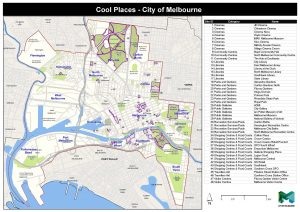Hollygrow is a local Hollygrove organization built at the former location of the Hollygrove Market and Farm. “Hollygrow brings together community through the spirit of growing & sharing.” Hollygrow is struggling financially and needs investment and support to continue its time as a staple of the Hollygrove community. They are a great organization with strong intentions so go give them some support!
Step Up Louisiana
Step Up Louisiana is an organization fighting to ‘build political power to win education and economic justice for all.” They have areas of focus including sustainable community schools and wage equity. Go check them out!
Hollygrove | Section 1
Hollygrove is a passionate neighborhood with exciting opportunities for growth and dedication for the youth. The goal of this video is to showcase certain overarching ideas that could be utilized throughout Hollygrove to create safer and resilient spaces for children. The video hits on the ideas of restoring nature within vacant lots, encouraging car owners to park at new pocket parking lots, in turn opening up the circulation system that is the streets, and opening up the green slice that runs through the heart of Hollygrove with the opportunities of creating a triangle of land connecting Larry Gilbert Stadium, Lafayette Academy, and the Green Strip and becoming a safe haven for the movement of all.
Who Are We?
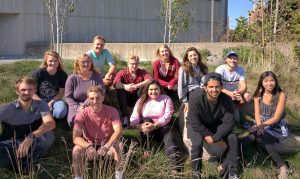
We are a group of Landscape Architecture students studying at Iowa State University. Why would Landscape Architecture students build this super cool website you ask? Well, the answer is simple: we care! As a field, Landscape Architecture is all about helping improve the lives and functions of people, spaces, and cities. Right now, our studio focus is on how we can make New Orleans a child-friendly city. This website is a tool and community meant for you. We’ve linked Resources, News & Events, and Initiatives here for you to explore and enjoy.
More About LA
What is Landscape Architecture? If you were to look it up in the dictionary, it would give you this definition: “the art and practice of designing the outdoor environment, especially designing parks or gardens together with buildings and roads”. The reality of Landscape Architecture is that its practice can be applied to many fields. This project utilizes large scale planning of urban design to create healthy and long-lasting changes to the fabric of New Orleans.
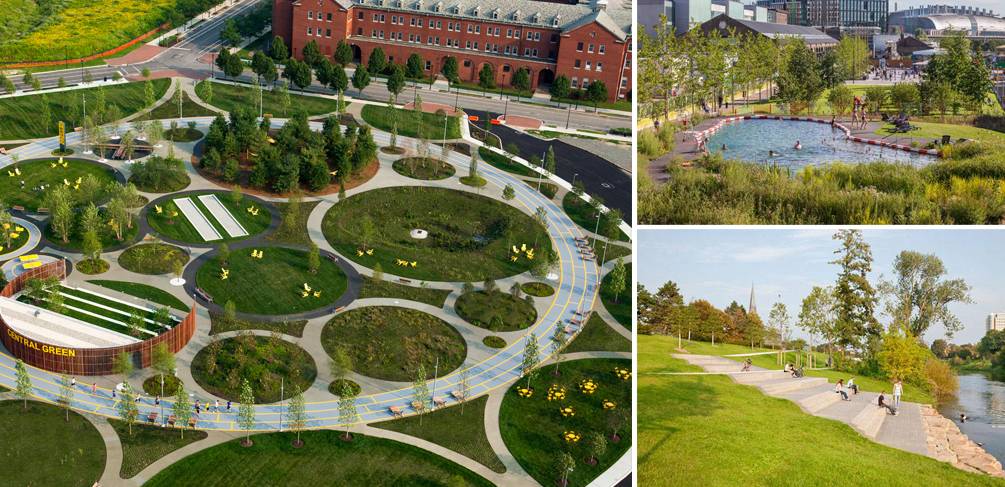
https://land8.com/top-10-landscape-architecture-projects-2015/
A Child Friendly Melbourne
What is Melbourne’s Future?
31.7% of Melbourne’s population is 24 years of age or younger. Creating safe, informative, and usable spaces and programs for these youth will drive the success of Melbourne for years to come. Melbourne is frequently known for its diverse culture but not necessarily for raising a family. However, there are programs and spaces designed with the youth in mind to try to create an appeal for the younger generations and families while supporting the less fortunate.
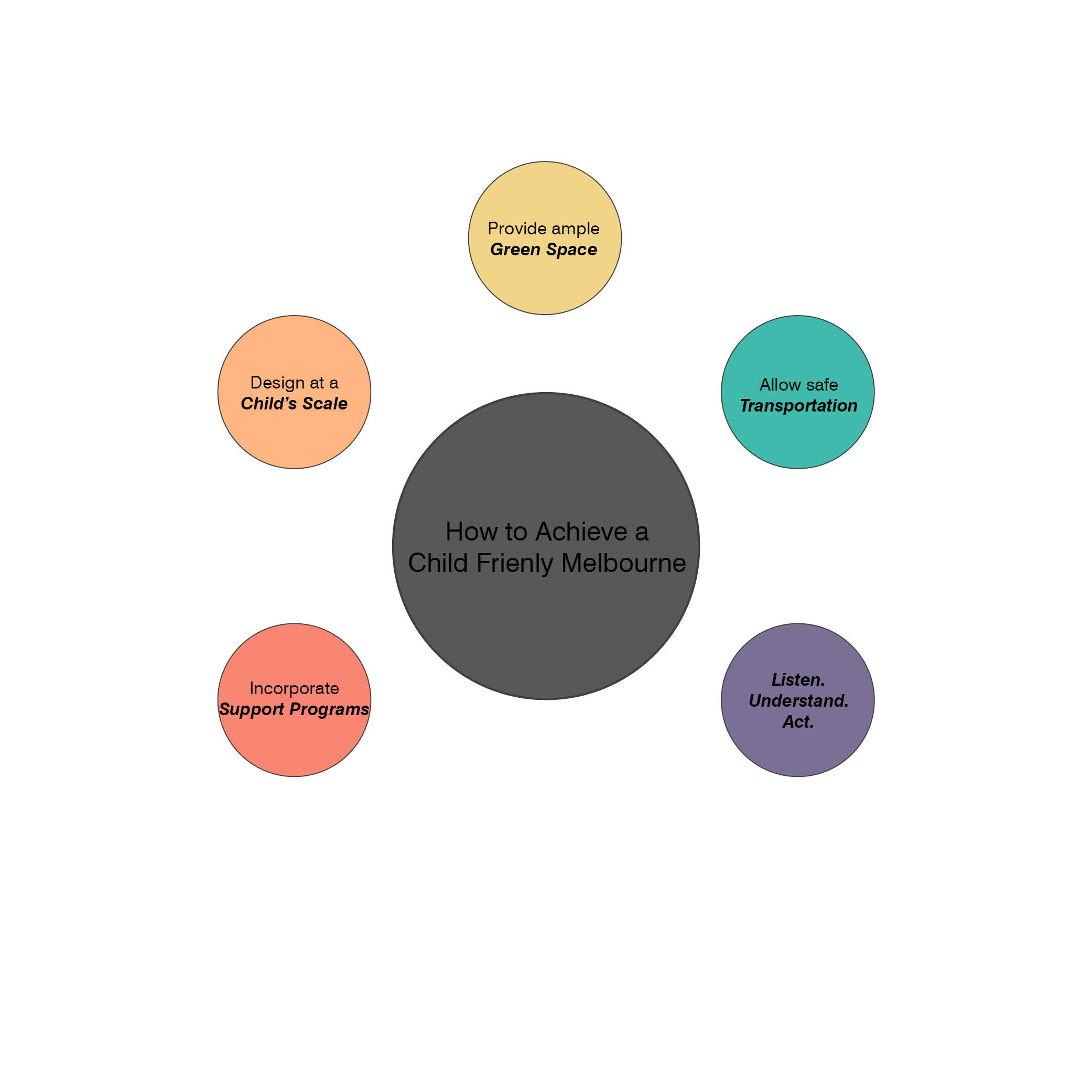
Youth Projects
With five different office locations in Melbourne, Youth Projects is an organization that provides support to disadvantaged, unemployed, homeless, alcohol and drug users, and young people looking to reengage with their community. For every 5 homeless people in Melbourne, 2 are under the age of 25 equating to about 28,000 young individuals being homeless on average every night. The mission of Youth Projects is to have High impact support. Without judgment. Fullstop. Youth Projects is a non-judgmental service that focuses on respect, client care, and harm prevention while understanding that everyone has their own complex web of struggles, difficulties, and needs.
Each year Youth Projects provides over 40,000 episodes of care helping to prevent homelessness from taking hold and to helping people to recover from homelessness and problems so they can get back on their feet again. An understanding of the importance of investing in youth is absolutely necessary. For every dollar funded for social support and employment, $10 returns to the city economy. Investing and including the youth benefits all stakeholders within the city.
Credit: youthprojects.org.au
Alma Park
Located Southeast of downtown Melbourne rests a 41-acre open space with sports fields, picnic areas, playgrounds, and open lawn. Alma Park is one of the most used park spaces in Melbourne and is very child and family-friendly. Alma Park is bordered by Alma Road, Westbury Street and Dandenong Road in St Kilda East. The park is split into East and West sections by the Sandringham train line. The park has open access from each street frontage. With multiple modes of transportation nearby including a tram, train, and free parking there are plenty of options for getting to the park.
Within the park consists of many features from attractions to facilities. Restrooms with accessible toilets, playground with junior and senior play areas, BBQ’s, picnic tables including longer tables for group gatherings, bench seats, drinking fountain, perimeter paths for walking, jogging and cycling, a large grassed reserve, wetland area, mature established shade trees and public artworks. Alma Park West is a designated dog off-leash area and Alma park East is a dog off-leash area only north of the sports oval.
In Alma Park, there are two separate play areas, the junior and senior playground. In the junior playground there is a two-story castle with slides, crawl tunnel and tubes, as well as multiple wood carved animals such as a kangaroo, wombat, and potteroo. In the senior playground, there are unique tree houses with climbing nets and play structures resembling imaginary creatures known as the ‘slug’ with climbing stairs and slides, flying fox (or zip line for us Americans) that is open every day, a sandbox with equipment like a seesaw, swings and a roundabout.
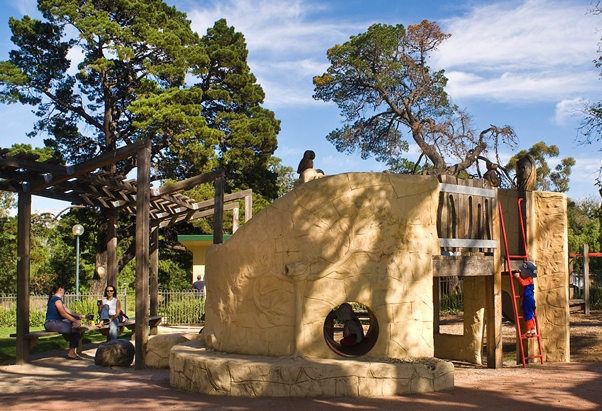
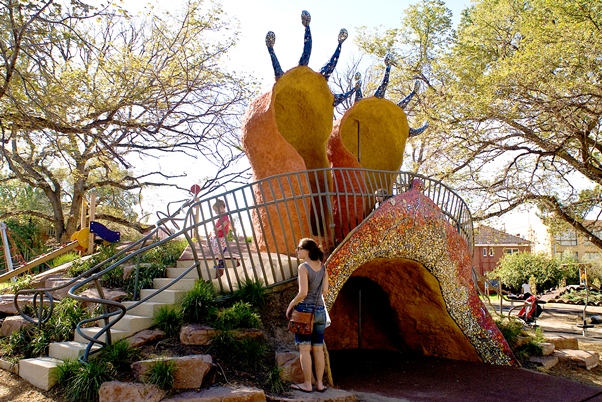
Credit: portphillip.vic.gov.au
Children’s Garden at Royal Botanic Gardens South Yarra
The Children’s Garden is a great place for kids who love getting their hands muddy to go. There is a Ruin Garden, Meeting Place with water features, a Wetland Area, Bamboo Forest, Gorge, Plant Tunnel, Kitchen Garden, and Rill (a quiet waterway running through the garden).
The Children’s Garden is an interactive educational environment in which children of all ages, backgrounds, physical abilities and cultures can play, explore and discover the natural world. It features plants, water, structures and pathways that reflect Melbourne’s changing seasons. The Children’s Garden is an interactive tool for environmental education and conservation made to intrigue teach and excite children from a young age. The garden was scaled with the very young in mind to create a sense of ownership and responsibility for the environment. The garden proudly is accessible for all.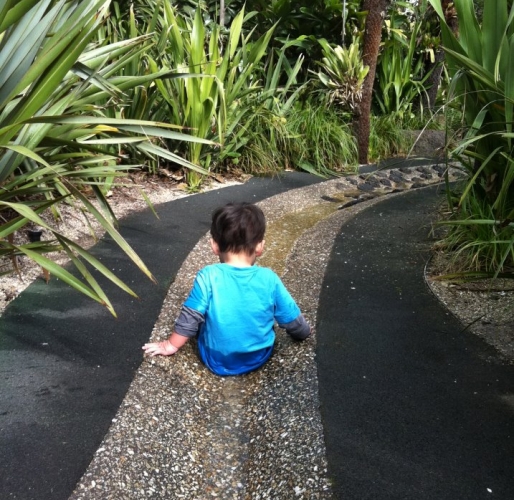
Credit: www.rbg.vic.gov.au
Melbourne, Australia
Why Climate Change Matters
Climate change has affected the natural environment and humans for centuries. From droughts beginning the decline of the Maya to the Vikings of Greenland being forced out to lowering temperatures, climate change has changed the way humans live. Understanding why it is happening and how we can slow down its effects will pave the way for a cleaner and greener future. The clearest present-day impacts of climate change in Australia and elsewhere are seen in the natural environment and are associated with warming temperatures and increases in the number, duration, and severity of heatwaves. These impacts include changes in the growth and distribution of plants, animals, and insects; negative shifts in the distribution of marine species; and increases in coral bleaching on the Great Barrier Reef and Western Australian reefs. Some of these changes can directly affect human activities; for example, through the effects of changing distributions of fish and other marine organisms on commercial and recreational fisheries, and the impacts of coral bleaching on tourism. With 85 % of all Australians living within 50 km of the shoreline, it is easy to see how devastating climate change can and will be.
Who Climate Change Affects

The population of Melbourne in 2018 was 4.9 million individuals. There are 1.8 million households in Melbourne with that number expected to grow to 2.4 million by 2036. Preparing these homes for the impacts of the future is critical to a resilient city.
![]()
With 31.7% of the public being 24 years of age or younger, it is extremely important to empower and educate this group in order for them to take action and make a difference. The Australian Youth Climate Coalition (AYCC) is the largest youth organized group in Australia trying to solve the climate crisis while educating the future of Melbourne.
Upon increasing temperatures, multiple cities in Victoria will be experiencing weather that is not normal for their ecological areas.
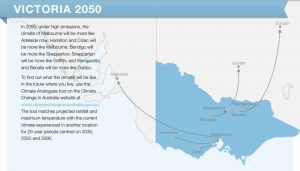
Credit: climatechange.vic.gov.au
These increasing temperatures will ultimately create more arid and unlivable cities.

Credit: climatechange.vic.gov.au
Negative Effects
Heat
Melbourne experiences nine very hot days (where temperatures exceed 35 degrees C or 95 F) on average each year. Climate models suggest this number will increase by up to 26 days on average by 2070. Heatwaves (five or more consecutive days of temperatures exceeding 35 degrees) are also predicted to increase in frequency.
Hundreds of people die each year from conditions exacerbated by extreme heat. The very young, elderly or sick are most vulnerable to extreme heat
Built-up areas experience higher temperatures than surrounding areas due to expanses of exposed concrete, asphalt, and steel which retain heat and release it over longer time periods than vegetation. This can cause average urban daytime air temperatures to be up to 5.6°C higher than the surrounding areas in summer. This means taking health precautions is particularly important during days of extreme heat in the city.
Higher temperatures have been correlated to increased levels of violence and antisocial behavior. Research undertaken for the City of Melbourne in 2012 indicated that the number of assaults in the municipality increased by 6.62 incidents per 100,000 persons for every one-degree temperature increase above 32 degrees.
Very hot days and heatwaves place stress on the provision of essential services such as electricity and many types of infrastructure including roads, train and tram tracks, and overhead power lines. Increased use of air-conditioners pushes up demand for power during heatwaves and can potentially outstrip supply leading to power blackouts. This risk has significant implications during a heatwave, particularly for those managing their heat stress with air-conditioning.
Not only is there a great threat to human health but there is also a risk of economic disaster. It is estimated that during the four-day January 2014 heatwave (14-17 January) businesses across the City of Melbourne experienced a $37 million decline in revenue. This equates to almost $10 million in lost revenue per day. Certain sectors such as retail and food and beverage appear to have been harder hit than others.
Credit: melbourne.vic.gov.au
Drought
Noting that Melbourne is likely to experience much warmer weather in the coming years, it is also very likely that the Melbourne water supply will come across some challenges.
The increasing frequency of drought and reduced rainfall poses challenges to Melbourne’s water supply, as well as the health of parks, trees and green spaces throughout the city.
Between 1998 and 2007 rainfall was 14 percent below average in Victoria. The annual average rainfall is predicted to decrease by 4 percent by 2030 and 11 percent by 2070, with the largest declines occurring in spring.
Fire risk will also become greater as droughts become more severe. The warmer, drier and longer summers expected in Victoria are very likely to increase the frequency and intensity of bush fires – with flow-on effects for air quality.
Credit: melbourne.vic.gov.au
Rising Sea Levels
Climate change is projected to increase average sea-levels along Victoria’s coast by 5 to 15 cm by 2030 and 26 to 59 cm by 2070. These changes will increase the likelihood and severity of floods and other inundation events like storm surges in Melbourne.
While the risks posed by sea-level rise are relatively negligible during the immediate future, they become far more concerning by 2070 with current climate change projections. Higher sea levels in 2070, coupled with more intense storms and increased storm surge heights, will greatly expand the coastal and riverine areas likely to be inundated by storm events. To see areas affected by increasing sea levels, go here.
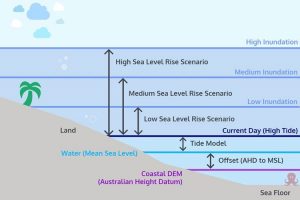
Credit: melbourne.vic.gov.au
What Is Being Done?
Immediate action to combat climate change is going to be crucial in the slowing of extreme temperatures, drought, and rising sea level. Melbourne has a list of initiatives and goals to move in the green direction for both the long and short term.
Urban Forest Strategy
The Urban Forest Strategy is a direct solution for urban heating and the Urban Heat Island Effect. With growing populations, climate change, and urban heating there is increasing pressure on the existing infrastructure and services of the city. Ensuring there is a thriving urban forest is critical to keeping a healthy and livable city.
The strategy aims to:
- adapt our city to climate change
- mitigate the urban heat island effect by bringing our inner-city temperatures down
- create healthier ecosystems
- become a water-sensitive city
- engage and involve the community.
We will achieve this by:
- increasing canopy cover from 22 percent to 40 percent by 2040
- increasing forest diversity with no more than five percent of one tree species, no more than ten percent of one genus and no more than 20 percent of any one family
- improving vegetation health
- improving soil moisture
- improving biodiversity
- informing and consulting with the community.
To help visualize this goal, an interactive map was made showing where individual trees within the city are and even see what the life expectancy and ID of each tree are. You can access this interactive map here.
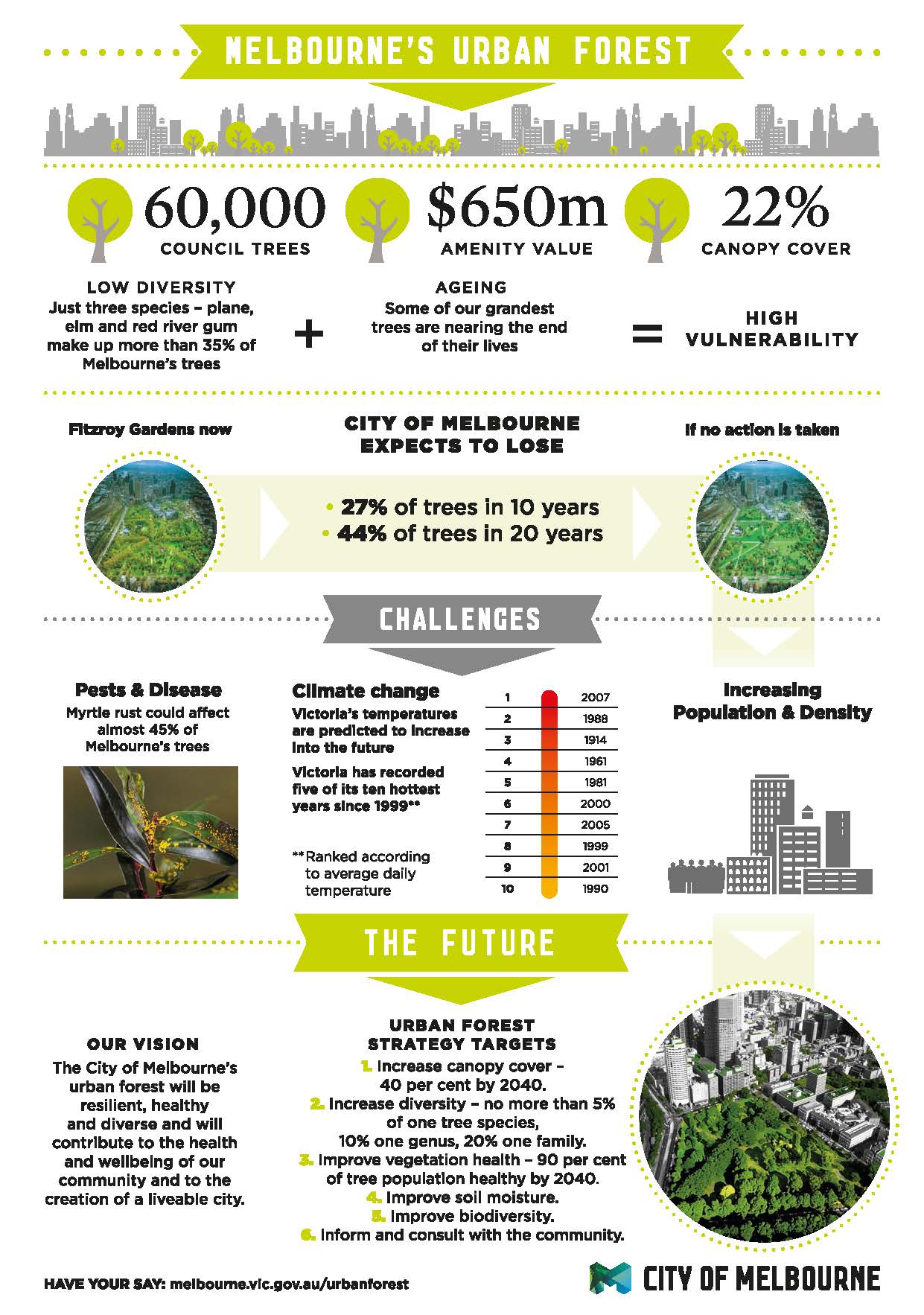
Credit: melbourne.vic.gov.au
Cool Roofs
Cool Roofs are strategies to reduce the heat transferred from roof to building and the surface below in an effort to mitigate the Urban Heat Island Effect. Most of the roofs in the world are dark-colored. This means in full sun, they absorb an extreme amount of heat, reaching up to 100 degrees F warmer than the ambient temperature. Using a cool roof will:
- Reduce energy use: A cool roof transfers less heat to the building below, so the building stays cooler and uses less energy for air conditioning.
- Reduce air pollution and greenhouse gas emissions: By lowering energy use, cool roofs decrease the production of associated air pollution and greenhouse gas emissions.
- Improve human health and comfort: Cool roofs can reduce air temperatures inside buildings with and without air conditioning, helping to prevent heat-related illnesses and deaths.
Utilizing cool roofs is an effective way to combat urban heating. Minimizing the urban heat island effect will make Melbourne a more resilient city.
Credit: certainteed.com, melbourne.vic.gov.au
Adaptation Strategy
In 2009, Australia released The Climate Change Adaptation Strategy which outlined a list of desired goals and outcomes for the coming years as well as methods for achieving these goals. Within this document, there were research and assessments of climate change risks for 2010, 2030, and 2070. The most recent version can be viewed here.
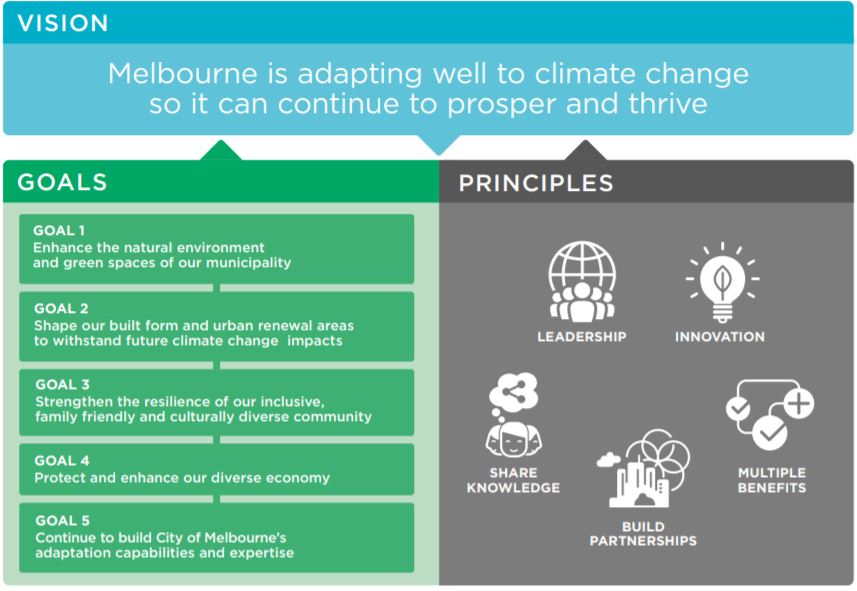
Sources
https://www.melbourne.vic.gov.au/about-council/vision-goals/eco-city/Pages/adapting-to-climate-change.aspx
https://www.environment.gov.au/climate-change/climate-science-data/climate-science/impacts
https://www.climatechange.vic.gov.au/__data/assets/pdf_file/0018/60750/Statewide-Victoria.pdf
https://www.science.org.au/learning/general-audience/science-climate-change/7-what-are-impacts-of-climate-change
https://theconversation.com/rapid-growth-is-widening-melbournes-social-and-economic-divide-117244
https://www.environment.gov.au/system/files/resources/fa553e97-2ead-47bb-ac80-c12adffea944/files/cc-risks-full-report.pdf
https://www.melbourne.vic.gov.au/sitecollectiondocuments/climate-change-adaptation-strategy-refresh-2017.pdf
https://www.certainteed.com/residential-roofing-commercial-roofing/what-cool-roof-0/
https://ozcoasts.org.au/maps-data/
http://www.coastalrisk.com.au
Home

